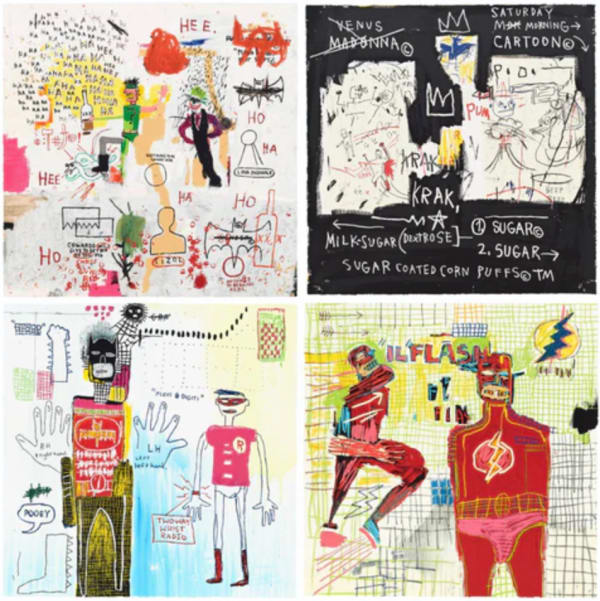Jean-Michel Basquiat’s art exists in a dynamic tension between the raw power of a streetwise vigilante and the fragile cadence of poetry. At first glance, his work feels aggressive—explosive compositions, slashes of color, and jagged text command attention. His graffiti roots and defiant style project the energy of rebellion. But beneath this confrontational veneer lies something more tender and lyrical: a poetic voice speaking in fractured symbols, metaphors, and coded references.
The vigilante aspect of Basquiat’s work emerges in his bold critique of systems of power. His paintings often challenge authority, racial injustice, and the erasure of Black histories. Like a street prophet, Basquiat uses his canvases to reclaim agency and spotlight the brutal contradictions of American life.
Yet, layered into this aggression is a profound sense of poetic reflection. Basquiat’s works are rich with repetition, fragmented language, and haunting symbols. Crowns, halos, and skeletal figures recur like stanzas. His references to jazz, literature, and anatomy build a visual syntax that reads like free verse. In his best works, the chaos is choreographed, the anger elevated into something lyrical. He uses language the way a poet might—with ambiguity, musicality, and rhythm.
This duality—the brutal and the beautiful—is what gives Basquiat’s art such lasting resonance. He was both a cultural insurgent and a poetic witness. His canvases pulse with the urgency of protest and the vulnerability of memory. That interplay—between shouting and whispering—makes Basquiat not only one of the most important artists of his generation but also one of its most human. His art doesn’t just speak; it declares and dreams, all at once.
-
-
 Jean-Michel BasquiatUntitled (from Leonardo), 1983
Jean-Michel BasquiatUntitled (from Leonardo), 1983 -
 Jean-Michel BasquiatThe Figure Portfolio, 1982 - 2023
Jean-Michel BasquiatThe Figure Portfolio, 1982 - 2023 -
 Jean-Michel BasquiatSuperhero Portfolio, 1982/87-2022
Jean-Michel BasquiatSuperhero Portfolio, 1982/87-2022 -
 Jean-Michel BasquiatCharles The First, from Portfolio II , 1982-2004
Jean-Michel BasquiatCharles The First, from Portfolio II , 1982-2004 -
 Jean-Michel BasquiatRome Pays Off, from Portfolio II, 1982-2004
Jean-Michel BasquiatRome Pays Off, from Portfolio II, 1982-2004 -
 Jean-Michel BasquiatOdours Of Punt, 1983-2024
Jean-Michel BasquiatOdours Of Punt, 1983-2024 -
 Jean-Michel BasquiatHollywood Africans , 1983-2015
Jean-Michel BasquiatHollywood Africans , 1983-2015 -
 Jean-Michel BasquiatPiano Lesson, from Superhero Portfolio , 1982/87-2022
Jean-Michel BasquiatPiano Lesson, from Superhero Portfolio , 1982/87-2022 -
 Jean-Michel BasquiatFlash In Naples, from Superhero Portfolio, 1982/87-2022
Jean-Michel BasquiatFlash In Naples, from Superhero Portfolio, 1982/87-2022 -
 Jean-Michel BasquiatBoxer Rebellion , 1982/83-2018
Jean-Michel BasquiatBoxer Rebellion , 1982/83-2018 -
 Jean-Michel Basquiat50 Cent Piece , 1982/83-2020
Jean-Michel Basquiat50 Cent Piece , 1982/83-2020 -
 Jean-Michel BasquiatUndiscovered Genius, 1982/83-2019
Jean-Michel BasquiatUndiscovered Genius, 1982/83-2019 -
 Jean-Michel BasquiatUntitled (Dog Leg Study), 1982/83-2019
Jean-Michel BasquiatUntitled (Dog Leg Study), 1982/83-2019
-
-














